Peterhof was built in the early eighteenth century by tsar Peter the Great as a magnificent palace and park complex meant to rival France’s Versailles. On an estate that covers more than six hundred hectares, Peter and his successors built some thirty palaces and pavilions in a mesmerizing display of wealth and power.
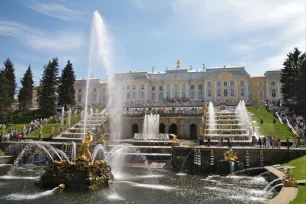
Peterhof is situated some 25 km (16 mi.) west of St. Petersburg and can be reached with a hydrofoil that brings you here from the quay in front of the Hermitage.
Northern War
Shortly after founding St. Petersburg in 1703, Peter the Great planned to build a country residence fitting for a ruler of his stature. But before he could start realizing his ambitions he had to secure the safety of St. Petersburg, which was threatened by the Northern War of 1700-1721, during which Russia battled for supremacy over the Baltic region with Sweden.
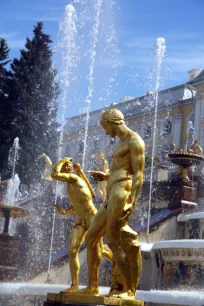
A modest start
During the war, Peter the Great regularly traveled to a remote place near the Gulf of Finland from where he could watch over the construction of fortifications in Kronstadt, on an island he had just conquered from Sweden. To reduce commuting time, his wife Catherine suggested building a small cottage, where he could reside during summer. The cottage, built in 1705, made Peter the Great realize the site was ideal for the construction of a grand country residence.
The creation of Peterhof
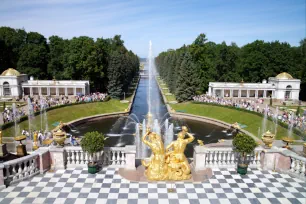
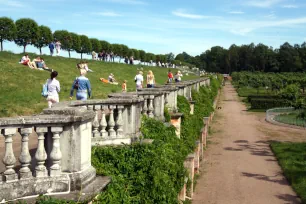
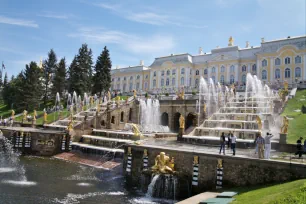
After Russia’s victory over the Swedish army in 1709 at Poltova and the naval victory at Gangut in 1714, the threat of a Swedish invasion had subsided and Peter started assembling a group of architects, engineers, landscape gardeners and artists to create his summer residence, Peterhof. Peter himself had already made a rough draft of his ambitious plans, which consisted of a centrally located palace surrounded by a large park dotted with numerous fountains, statues and cascades. After his visit to Versailles in 1717 his plans became even more grandiose.
Construction started in earnest in 1714 when thousands of workers, including soldiers and serfs, were brought in so that the park and palaces could be created in a short timeframe. Building materials, decorations and plants – mostly from Western Europe – were transported over water and a grand canal was dug between the main palace and the sea. The main palace was completed first, in 1721. Two years later, on August 14, 1723, Peterhof officially opened. Work would continue for many years on decorations and several smaller palaces on the estate. Peterhof became the favorite residence of the tsars, several of whom expanded and renovated the main palace.
During the siege of the city during World War II, Peterhof was occupied by German troops, who left it in ruins. Reconstruction of the park and palaces lasted for more than sixty years.
Great Palace
The main palace in Peterhof – also dubbed the Great Palace – was built between 1714 and 1721 after a design by architect Jean-Baptiste le Blond who followed Peter the Great’s initial drafts that showed a large, two-storied villa with two wings perched on top of a hill.
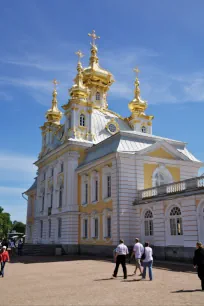
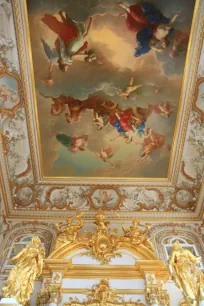
During the reign of Empress Elisabeth, daughter of Peter the Great, the palace was significantly altered and expanded by the Italian architect Francesco Bartolomeo Rastrelli, who added another floor, a new palace wing and a small domed church. The interior was remodeled in a baroque style, although Peter the Great’s study room was left intact.
The Palace was further embellished during the reign of Catherine the Great, when Yury Felten redecorated the Throne Room – the largest room in the Great Palace at 300 sq. m. The room is part of a series of opulent state rooms which can be reached via the magnificent ceremonial staircase, created by Rastrelli and decorated with gilded statues. The adjacent Chesma Hall is embellished with wall paintings depicting the naval battle of Chesma between Russia and the Ottoman Empire.
At the center of the palace is the Picture Hall – named for the portraits that hang on the wall of this large hall. The hall leads to the other wing of the palace, where the spacious and airy Ballroom is the most magnificent. The windows and mirrors on either side of the room create the illusion of an even larger hall. Other notable rooms in the palace include the baroque Audience Hall, the blue Drawing Room, the white Dining Room, two Chinese study rooms and the original study room of Peter I.
The Park
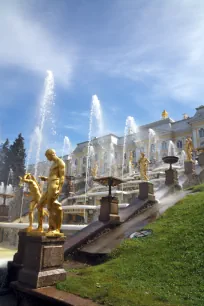
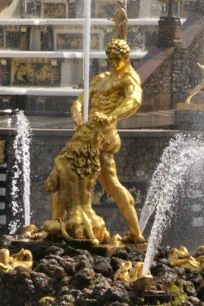
The domain of Peterhof is divided into three separate parks; it includes the upper park, lower park and the Alexandriapark.
The lower park is the most crowded due to its many attractions including the Grand Cascade, the Grand Canal, several small palaces and numerous fountains and sculptures. The fountains in particular are magnificent and attract throngs of visitors. The upper park is more formally laid out, with flower beds arranged around large basins. The main highlight here is the Neptune Fountain. The Alexandria Park is the most romantic of the three and also the least crowded due to its remote location.
Grand Cascade
The star feature of Peterhof is the magnificent Grand Cascade, completed in 1724 as the centerpiece of the waterworks plan, which was created after Peter the Great witnessed the Grand Canal and fountains of the Versailles Palace.
The plan consisted of a large cascade which runs from the foot of the Great Palace to a long canal that leads to the Gulf of Finland. Numerous other elaborate fountains were incorporated into the plan. Water was supplied by a natural spring nearby.
At the center of the famous Grand Cascade is the Samson Fountain, which shows the biblical hero Samson opening the jaws of a lion. The statue symbolized Russia’s victory over Sweden at Poltava. The cascade alone is decorated with thirty-nine gilded bronze statues and seventy-five fountains. On a terrace at the top of the cascade – which offers great views towards the sea – are a pair of Tritons and an array of gilded sculptures depicting ancient heroes adorn the seventeen steps that lead to the Grand Canal. Bas-reliefs on the fronts of the steps further glorify the victorious Russian nation.
More Palaces and Fountains
Several subsidiary palaces were built throughout the park, with a distance of three kilometers (2 mi.) separating the Marly Palace at the western end of the park with the Cottage Palace at the eastern end.
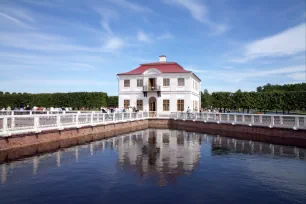
Marly Palace was built in 1720-1724 to accommodate important guests of Peter the Great. The palace has its own cascade, the Golden Hill Cascade.
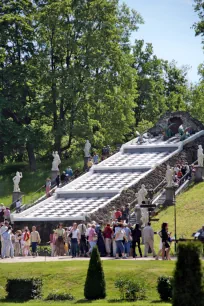
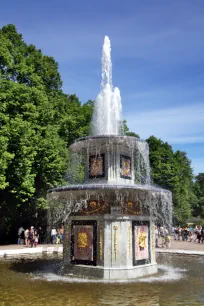
While not as monumental in ornamentation as the Grand Cascade, it is an aesthetically pleasing cascade flanked by a series of marble statues. Nearby is the Hermitage Pavilion, a small building with a white colored facade that was built in 1721-1725 near the waterfront.
Further along the waterfront stands the Monplaisir Palace, at the center of a small park that is divided into six differently themed gardens, including a Chinese garden and a labyrinth. This delightful palace is the oldest in the lower park, completed in 1723. The dragon waterfall nearby is named after the three statues of dragons that spout water onto a checkerboard patterned sloping plane.
More towards the Grand Palace is the Orangery, built to protect plants and flowers from inclement weather.
In front of the Orangery stands the Triton Fountain, and to the east are a couple of eighteenth-century marble fountains known as the Roman Fountains.
Further east towards the Cottage Palace, one can see the imposing contours of the Royal Stables, which seems out of place here with its Tudoresque style. At the park’s eastern end, in the English styled Alexandria park, stands the even more curiously looking Cottage Palace. It was built in the early nineteenth century for tsar Nicholas I and his wife Alexandria, after whom the park was named. The Cottage was designed in an English Gothic style by the Scottish architect Adam Menelaws.

